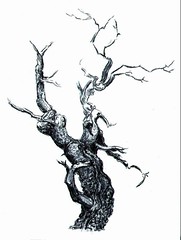
My recent post about Centric Systems is a good introduction to this one as it can help prepare one to think "concentrically." Even so, this is not the easiest subject to wrap your mind around, so I'll keep the subject of this post very narrow (and will write more "narrow" posts in the future to get at this bit by bit), and probably simpler than you would like (I write these posts for myself, too, so I try to make things simple and memorable).
When Rudolf Arnheim ("German-born author, art and film theorist and perceptual psychologist" - Wikipedia) wrote about "centers" he was almost always referring to "perceptual" centers. In this post I want to introduce perceptual centers and show how a perceptual center is different than a geometric or a physical center.
THE GEOMETRICAL CENTER
You can only find the geometrical center of something in a figure that is symmetrical, for instance a circle. This is how I do it:
First I put the circle inside a square and then I draw diagonal lines from corner to corner and where the lines cross is the
geometric center of the circle. It's right in the middle, as are all geometric centers. (Geometrically, only regular figures have centers.)
You may at first wonder: Aren't all centers in the middle? No, they're not.
THE PHYSICAL CENTER
Take a look at the man holding up the little car, below.
Otto Acron lifting 1500 pounds.
You probably noticed right away that Mr. Acron is not right in the middle between the front and the back of the car; rather, the weight is distributed evenly to the left and right of him, the engine in the front, of course, weighing more than the seats in the back. He has found the physical center of the car.
THE PERCEPTUAL "BALANCING CENTER"
What artists are more concerned with than either the geometric or physical center is the perceptual balancing center (usually just called the balancing center) of a composition. Sometimes the balancing center is in the geometric center, but usually it is not. We locate perceptual centers intuitively, not by weight or measure.
The Sakyamuni Buddha painted by Zhang Shengwen, China - 1173-1176 - Image from Wikimedia
In the painting above, the balancing center is in fact in the geometric center and that's where you find the Buddha (It is not always necessary that a balancing center has anything at all in it, but here it does). The other people are arranged symmetrically (though not perfectly symmetrically) to his sides and to the front ("below" in the picture). Everyone, including the Buddha at the balancing center, has a circular "halo" behind his or her head. The smaller the figure, the smaller the halo. Although I haven't read who these people are meant to be or what their relationships are to each other and to the Buddha, it seems obvious to me that even if we don't know their names we can infer the place of everyone in the hierarchy by size comparisons, and also distance from not only the central figure but also from those they are closest to, especially those with slightly larger halos who are in some way "superior" to them ....In other words, there are hierarchies within hierarchies (i.e., "centers" within "centers" -- as, for example, a galaxy has "suns" and some of those suns have planets and some of those planets have moons; or as trees have trunks from which sprout branches, from which sprout twigs, from which sprout leaves). The edges of the painting also are considered perceptual "centers" as they also have an effect on perceived relationships within the picture.
Most pictures are not symmetrical, though many are.
Although I've used a symmetrical (though less than perfectly so) painting as an example, most pictures are not symmetrical. That's because they're about life as lived here on earth, not in some mythological "other world" where everything is perfect and never changes. Living in the "real world" implies movement and change, and movement and change are not qualities that are projected by squares or circles or the perfect reflection on one side of a center of what is on the other side. Symmetrical compositions (especially when they are round or square) imply stability and timelessness and so are useful for statements about things that are permanent; obviously the relationships shown in the Buddha painting were not felt by the artist to be in danger of changing. But most paintings are about the struggles and strivings and desires and so on that take place in a society in which everything and everyone does not have a permanent place ... unexpected things happen, planned changes occur, challenges to the present order are constant and often to some degree effective; and of course we - people, animals, plants - grow older, and eventually die (we are always changing), and so most pictures that are about real life are not meant to look like they're frozen in time, but rather like they are "happening." This is why the centers are not usually symmetrically placed.
Most pictures have more than one center.
There are usually several perceptual centers (Arnheim sometimes refers to them as "dynamic" centers) in a picture, which balance around the one balancing center. The balancing center is usually located at or near the actual geometrical center of the picture. Other centers in the picture (not the "balancing" center) are placed in relation to the balancing center and to other centers.
What is a perceptual center?
Arnheim defines a perceptual center as "the center of a field of forces, a focus from which forces issue and toward which forces converge."
What is a dominant (or principal) center?As I understand it, Arnheim uses these terms interchangeably instead of "focal point."
What is a balancing center?
Arnheim says the balancing center is "where all the forces balance one another."
What is this about "forces?" (Also called perceptual forces)
"Visual experience is dynamic....What a person or animal perceives is not only an arrangement of objects, of colors and shapes, of movements and sizes. It is, perhaps first of all, an interplay of directed tensions. These tensions are not something the observer adds, for reasons of his own, to static images. Rather, these tensions are as inherent in any percept as size, shape, location, or color. Because they have magnitude and direction, these tensions can be described as psychological 'forces.'" -- Rudolf Arnheim (Art and Visual Perception, Chapter IX: Dynamics).
I'll attempt to explain more about this subject in upcoming posts. - Jean

A Centric (or Concentric) System
| Definitions from The Power of the Center: BALANCE: The dynamic state in which the forces constituting a visual configuration compensate for one another. The mutual neutralization of directed tensions produces an effect of immobility at the balancing center. CENTER: Geometrically, the center is defined purely by location as the point equi-distant from all homologous points of a regular figure. Physically, the center is the fulcrum around which an object balances [as in the car being lifted, above]. Perceptually, the balancing center is the point at which all the vectors constituting a visual pattern are in equilibrium. In a broader sense and irrespective of location, any visual object constitutes a dynamic center because it is the seat of forces issuing from it and converging toward it. |
RELATED POSTS:
Centric Systems
Round Artworks
The Tondo
NOTES:
1) This post was edited on April 17, 2011, and will be further edited, though that "further editing" will mostly have to do with the term "perceptual center." Arnheim used different terms that meant the same thing and I hope to make it less confusing.
2) Quotations in this post are from Rudolf Arnheim's books Art and Visual Perception and The Power of the Center.
3) Most of what I have learned (and am continuing to learn) about centers and related subjects is inspired by Rudolf Arnheim's explanations of these things, but it has not been easy to decipher his books though I've read his three most important books (Art and Visual Perception, The Power of the Center, and Visual Thinking) over and over and over again (as well as having read once so far most of the others, all of which I have). In fact two of my Arnheim books especially were literally falling apart until just the other day when I pulled out all the pages that had not already fallen out, then punched holes in them and put them in looseleaf notebooks. They are much easier to read now.

There are some things in the books, of course, which are easily grasped right away (and they are fascinating, which is what causes me to keep at these books -- as well as others of Arnheim's books), and each time I go back and read a book again more of it makes sense to me. But large chunks of his writing were almost impenetrable to me at first. It's because of this that once I feel I really "get" something I try to explain it and illustrate it here so I'll have it written and illustrated for myself (lest I forget any of it!), and hoping it might be of some help to others.
4) The picture of the Buddha painting by Zhang Shengwen and also the picture of the centric system are in the public domain. I made the picture of the circle with the square and the diagonal lines, and of course I took the photo just above; I don't mind if you'd like to use either one of them for anything. - Jean


0 comments:
Post a Comment